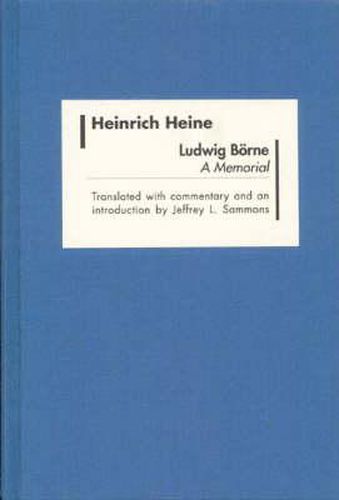Readings Newsletter
Become a Readings Member to make your shopping experience even easier.
Sign in or sign up for free!
You’re not far away from qualifying for FREE standard shipping within Australia
You’ve qualified for FREE standard shipping within Australia
The cart is loading…






In 1840, Heinrich Heine, the major German poet of Jewish origin of the age, published a book on Ludwig Boerne, the major German political writer of Jewish origin of the period, who had died three years before. Regarded by Heine andothers as his best-written book, it was also his most disastrously conceived. Intended to recover the high ground of revolutionary principle and philosophy against the attacks mounted on him by Boerne and his supporters, the bookwas instead met by a storm of outrage from which it seemed Heine’s reputation might never recover. In the course of time, the evaluation was reversed; Heine was increasingly celebrated as a true herald of revolution. His vocabulary of Hellenism and Nazarenism, employed for the first time in Boerne, was transmitted into English usage by Matthew Arnold. But Boerne itself is Heine’s only major work that has never been fully translated into English. The commentary to the edition clarifies the conflict between the two most prominent German-Jewish public intellectuals of their time, corrects the misapprehensions constantly in circulation about their relationship and the book,and reveals the many peculiarities of the text.
Jeffrey L. Sammons is Leavenworth Professor of German Emeritus at Yale University and the author of four books on Heine.
$9.00 standard shipping within Australia
FREE standard shipping within Australia for orders over $100.00
Express & International shipping calculated at checkout
In 1840, Heinrich Heine, the major German poet of Jewish origin of the age, published a book on Ludwig Boerne, the major German political writer of Jewish origin of the period, who had died three years before. Regarded by Heine andothers as his best-written book, it was also his most disastrously conceived. Intended to recover the high ground of revolutionary principle and philosophy against the attacks mounted on him by Boerne and his supporters, the bookwas instead met by a storm of outrage from which it seemed Heine’s reputation might never recover. In the course of time, the evaluation was reversed; Heine was increasingly celebrated as a true herald of revolution. His vocabulary of Hellenism and Nazarenism, employed for the first time in Boerne, was transmitted into English usage by Matthew Arnold. But Boerne itself is Heine’s only major work that has never been fully translated into English. The commentary to the edition clarifies the conflict between the two most prominent German-Jewish public intellectuals of their time, corrects the misapprehensions constantly in circulation about their relationship and the book,and reveals the many peculiarities of the text.
Jeffrey L. Sammons is Leavenworth Professor of German Emeritus at Yale University and the author of four books on Heine.